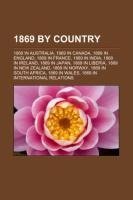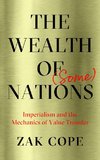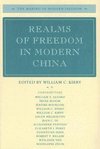
1869 by country
Source: Wikipedia. Pages: 48. Chapters: 1869 in Australia, 1869 in Canada, 1869 in England, 1869 in France, 1869 in India, 1869 in Ireland, 1869 in Japan, 1869 in Liberia, 1869 in New Zealand, 1869 in Norway, 1869 in South Africa, 1869 in Wales, 1869 in... Viac o knihe
Produkt je dočasne nedostupný
16.46 €
bežná cena: 18.70 €
O knihe
Source: Wikipedia. Pages: 48. Chapters: 1869 in Australia, 1869 in Canada, 1869 in England, 1869 in France, 1869 in India, 1869 in Ireland, 1869 in Japan, 1869 in Liberia, 1869 in New Zealand, 1869 in Norway, 1869 in South Africa, 1869 in Wales, 1869 in international relations, 1869 in the United Kingdom, 1869 in the United States, Boshin War, 1st Canadian Parliament, Titokowaru's War, Avondale Mine Disaster, 1869 Saxby Gale, Republic of Ezo, Battle of Hakodate, Cook-Folsom-Peterson Expedition, Golden spike, Rajputana famine of 1869, Blackburn by-election, 1869, List of sovereign states in 1869, List of state leaders in 1869, Battle of Summit Springs, Naval Battle of Miyako Bay, Naval Battle of Hakodate Bay, 21st New Brunswick Legislative Assembly, Welcome Stranger, Dalton Junction rail crash, Spencer v Harding, National Peace Jubilee, Star of South Africa, The Great Fire of Whitstable, 1869, Aboriginal Protection Act 1869, Judiciary Act of 1869, Irish Church Act 1869, French legislative election, 1869, George v Skivington, First inauguration of Ulysses S. Grant, 1869 English cricket season, Liberian general election, 1869, List of colonial governors in 1869. Excerpt: The Boshin War Boshin Senso, "War of the Year of the Dragon") was a civil war in Japan, fought from 1868 to 1869 between forces of the ruling Tokugawa shogunate and those seeking to return political power to the imperial court. The war found its origins in dissatisfaction among many nobles and young samurai with the shogunate's handling of foreigners following the opening of Japan during the prior decade. An alliance of southern samurai; particularly the domains of Choshu, Satsuma and Tosa, and court officials secured control of the imperial court and influenced the young Emperor Meiji. Tokugawa Yoshinobu, the sitting shogun, realizing the futility of his situation, abdicated political power to the emperor. Yoshinobu had hoped that by doing this, the Tokugawa house could be preserved and to participate in the future government. However, military movements by imperial forces, partisan violence in Edo, and an imperial decree promoted by Satsuma and Choshu abolishing the house of Tokugawa led Yoshinobu to launch a military campaign to seize the emperor's court at Kyoto. The military tide rapidly turned in favor of the smaller but relatively modernized imperial faction, and after a series of battles culminating in the surrender of Edo, Yoshinobu personally surrendered. Those loyal to the Tokugawa retreated to northern Honshu and later to Hokkaido, where they founded the Ezo republic. Defeat at the Battle of Hakodate broke this last holdout and left the imperial rule supreme throughout the whole of Japan, completing the military phase of the Meiji Restoration. Around 120,000 men were mobilized during the conflict, and of these about 3,500 were killed. In the end, the victorious imperial faction abandoned its objective to expel foreigners from Japan and instead adopted a policy of continued modernization with an eye to eventual renegotiation of the Unequal Treaties with the Western powers. Due to the persistence of Saigo Takamori, a prominent leader of the imperial factio
- Vydavateľstvo: Books LLC, Reference Series
- Formát: Paperback
- Jazyk:
- ISBN: 9781156359112


 Anglický jazyk
Anglický jazyk 



 Ruský jazyk
Ruský jazyk 





